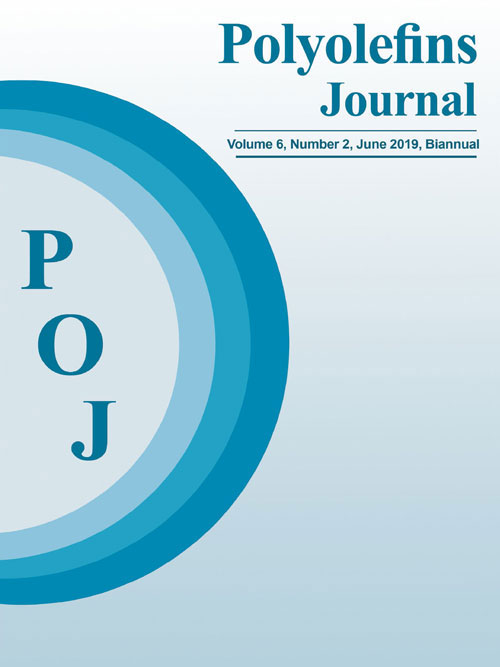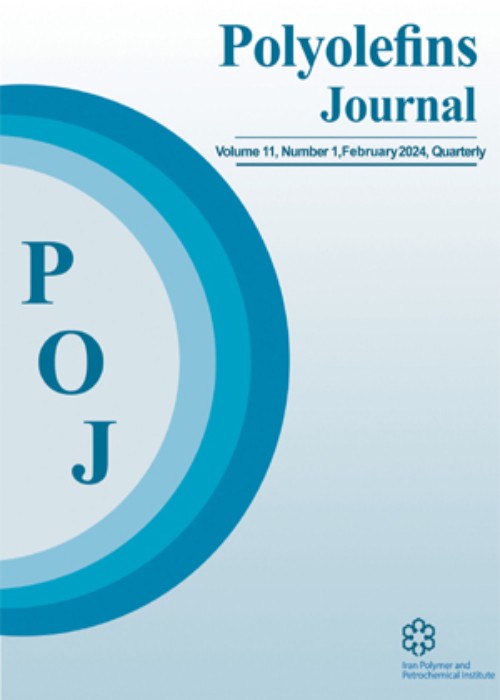فهرست مطالب

Polyolefins Journal
Volume:7 Issue: 1, Winter-spring 2020
- تاریخ انتشار: 1398/11/16
- تعداد عناوین: 5
-
-
Pages 1-11
Coordinative chain transfer polymerization (CCTP) has opened a new path for the development of novel products like olefin block copolymers and chain-end functional polyolefins. However, conflicting results are frequently reported on the catalyst performance including activity and comonomer selectivity under CCTP conditions. Here we have selected two catalysts including rac-ethylenebis(1-η5-indenyl)zirconocene and bis(imino) pyridine iron, with drastically different comonomer affinities. The effect of diethyl zinc as the chain transfer agent (CTA) on their individual performances is evaluated at different 1–hexene concentrations, in copolymerization with ethylene. Combined thermal fractionation and GPC results confirm that not all chains experience the reversible transfer reaction. Nevertheless, the metallocene catalyst shows twice activity and about 30% lower comonomer incorporation in the presence of CTA. Conversely, the late transition metal catalyst demonstrates lower activity and remains comonomer irresponsive. It could be concluded that, in addition to establishing a reversible transfer reaction, CTA affects the nature of active centers. This finding can help designing olefin copolymers with a more defined chemical composition based on CCTP reaction.
Keywords: coordination polymerization, reversible chain transfer reaction, chemical composition, microstructure -
Pages 13-24The application of membranes in various industries is one of the most urgent needs to reduce energy consumption and environmental pollutants as well as low investment costs in the process of separation. In this investigation, the optimization of effective parameters for separation of gas mixture of CH4, CO2, O2 and N2 is studied by modified poly(4-methyl-1-pentane) (PMP) membrane including nanoparticles (TiO2, ZnO, Al2O3). Design expert software was used and prevailing data on membrane modeling were categorized according to the process variables such as permeability, selectivity, composition and percentage of nanoparticle, and gas pressure difference. In order to validate the model, the results predicted by the model were compared with the experimental data. Good agreement was observed between the predicted and experimental data, and it was found that nanoparticles have a considerable effect on the results. In the case of gas permeability, the best results were obtained for the nanoparticles of alumina (15 wt%) at the pressure of 3 bar. However, titanium dioxide nanoparticle (10 wt%) at the pressure of 9 bar showed the best results for gas selectivity. The optimum point for both permeability and selectivity was obtained for the membrane containing 10 wt% titanium dioxide at 5 bar.Keywords: Poly (4-methyl-1-pentane), Permeability, Selectivity, Titanium dioxide, Aluminum oxide
-
Pages 25-32
Crystallinities of high-density polyethylene (HDPE) films containing various amounts of an oxo-biodegradable additive (HES-W) were investigated immediately after preparation and 6 weeks after ultraviolet (UV) irradiation (λ=254 nm). HDPE granules were mixed with oxo-biodegradable masterbatch in a twin-screw extruder and the extrudates were converted into films with thicknesses of 35±5 micrometers. The films were exposed to UV light for 6 weeks. Crystallinities of the films are investigated by X-ray diffraction spectroscopy (XRD) and differential scanning calorimetry (DSC). The XRD results show that upon UV exposure, the crystallinities of the films enhance. The DSC thermograms have confirmed the XRD results and also show a decrease in melting points of the samples after UV exposure. Further investigations on viscosity average molecular weights (Mv) of the samples show that their Mv decrease sharply after UV exposure. Scanning electron microscopy (SEM) shows clear cracks on the samples surfaces after 6 weeks exposure to UV irradiation. Investigating the functionalities of the polymers through Fourier transform infrared spectroscopy (FTIR) show the emergence of carbonyl peaks after UV irradiation so that the carbonyl index of the samples increases. It is concluded that maximum oxo-biodegradation enhancement of the HDPE film samples can be achieved by using a specific amount of the oxo-compound (3 wt%); furthermore the crystallinities of the samples show considerable enhancement after UV exposure which can be due to better packing ability of low molecular weight chains along with probable dipole-dipole attractions between the carbonyl groups on different newly formed short polar chains.
Keywords: Oxo-biodegradability, High Density Polyethylene, Crystallinity, UV irradiation, supercooling effect -
Pages 33-44The condition of oligo-micelle formation of sodium di-isodecyl sulfosuccinate (SDIDS) emulsifier in hydroalcoholic solutions is used to study particle formation of vinyl chloride emulsion polymerization in a batch reactor. The change on micellization behavior was investigated by critical micelle concentration (CMC) and zeta potential parameters. To detect the occurrence of secondary nucleation or particle aggregation, or both the particle size and number of particles were investigated as a criterion for the particle nucleation and growth process. The results showed that the alcohol (co-solvent) content had a strong effect on the oligo-micelles formation and emulsion polymerization performance. Namely, decreasing the alcohol content and increasing the anion content in the SDIDS samples increased the overall reaction rate and latex stability. This also decreased the chain growth rate, the particle size, and the coarse particle formation. Also, the results showed that different condition of oligo-micelle formation would lead to different particle growth historyKeywords: emulsion polymerization, Poly (vinyl chloride), Double-chain emulsifier, oligo- micelle, Particle Growth
-
Simulation and modeling of macro and micro components produced by powder injection molding: A reviewPages 45-60
During the recent years powder processing technologies have gained much attention due to the less energy consumption and recyclable powders. Manufacturing of complicated parts by the conventional powder metallurgy (PM) method is hard due to the uniaxial pressure, which leads to the low design flexibility. In order to prevail these constraints, powder injection molding (PIM) process, which includes powder metallurgy and injection molding processes, is introduced. In powder injection molding, simulations are a very useful tool to predict each step of process and design the mold. By this way, design can already be optimized and mistakes are avoided. In this review a detailed study of simulation of different steps in the powder injection molding process of macro and micro components produced by this method is presented. Simulation investigations of mixing, injection, debinding, and sintering of various researchers are given. The computer simulation tools available for all steps of the PIM process are surveyed and results are presented.
Keywords: powder injection molding, simulation, debinding, sintering, injection


